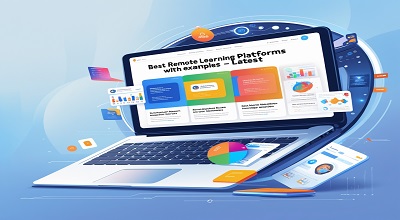Best Remote Learning Platforms
Best Remote Learning Platforms: The shift toward digital education has made remote learning platforms more essential than ever. Whether for K-12 students, higher education, or professional development, these platforms provide flexible, interactive, and accessible learning experiences. This article explores the best remote learning platforms available today, along with real-world examples and their latest features.
Why Remote Learning Platforms Are Important
Remote learning platforms offer numerous benefits:
- Flexibility: Learn anytime, anywhere.
- Accessibility: Reach students globally.
- Interactive Tools: Engage learners with multimedia.
- Cost-Effective: Reduce physical infrastructure costs.
- Personalized Learning: Adaptive learning technologies cater to individual needs.
With advancements in AI, gamification, and cloud-based solutions, remote learning is evolving rapidly.
Top Remote Learning Platforms in 2025
Here’s a detailed look at the best remote learning platforms, categorized by their primary use cases.
1. Learning Management Systems (LMS)
LMS platforms help institutions and businesses manage, deliver, and track online courses.
A. Moodle
- Features: Open-source, customizable, SCORM-compliant.
- Example Use: Universities like UCLA and the Open University use Moodle.
- Latest Updates: Enhanced AI-driven analytics and mobile app improvements.
B. Blackboard Learn
- Features: Robust assessment tools, virtual classrooms.
- Example Use: Used by NYU and Harvard Extension School.
- Latest Updates: Deeper Microsoft Teams integration.
C. Canvas by Instructure
- Features: User-friendly, cloud-based, strong API support.
- Example Use: Adopted by Stanford and Yale.
- Latest Updates: AI-powered grading assistance.
2. Virtual Classroom Platforms
These platforms simulate real classrooms with live interactions.
A. Zoom for Education
- Features: Breakout rooms, webinar hosting, recording.
- Example Use: Widely used in schools and corporate training.
- Latest Updates: Enhanced security and engagement analytics.
B. Google Classroom
- Features: Seamless Google Workspace integration.
- Example Use: Popular in K-12 schools globally.
- Latest Updates: AI-assisted assignment suggestions.
C. Microsoft Teams for Education
- Features: Integration with Office 365, assignment tracking.
- Example Use: Deployed in many school districts.
- Latest Updates: Reading Progress tool for literacy tracking.
3. MOOC Platforms (Massive Open Online Courses)
MOOCs provide free or paid courses from top universities and organizations.
A. Coursera
- Features: Courses from Stanford, Google, IBM.
- Example Use: Professional certifications in tech and business.
- Latest Updates: More hands-on projects with Coursera Labs.
B. edX
- Features: University-backed courses, MicroMasters programs.
- Example Use: MIT and Harvard courses.
- Latest Updates: Expanded financial aid options.
C. Udemy
- Features: Wide variety of courses, lifetime access.
- Example Use: Skill development for professionals.
- Latest Updates: AI-curated learning paths.
4. Specialized Learning Platforms
These cater to niche learning needs, such as coding or language learning.
A. Duolingo
- Features: Gamified language learning.
- Example Use: Over 500 million users worldwide.
- Latest Updates: AI chatbots for conversational practice.
B. Codecademy
- Features: Interactive coding exercises.
- Example Use: Used by aspiring developers.
- Latest Updates: More advanced career paths.
C. Khan Academy
- Features: Free K-12 and test prep resources.
- Example Use: Used in schools for supplemental learning.
- Latest Updates: New SAT prep tools.
5. Corporate Training Platforms
Designed for employee upskilling and compliance training.
A. LinkedIn Learning
- Features: Expert-led courses, LinkedIn integration.
- Example Use: Used by companies like Adobe for training.
- Latest Updates: Personalized course recommendations.
B. TalentLMS
- Features: Easy-to-use, customizable.
- Example Use: Small to mid-sized businesses.
- Latest Updates: Improved gamification features.
C. Docebo
- Features: AI-driven, supports social learning.
- Example Use: Enterprises like Walmart and Thomson Reuters.
- Latest Updates: Enhanced reporting dashboards.
Comparison of Top Remote Learning Platforms
| Platform | Best For | Pricing | Key Feature |
|---|---|---|---|
| Moodle | Universities | Free (Open-source) | Highly customizable |
| Google Classroom | K-12 Schools | Free | Google Workspace integration |
| Coursera | Professional Courses | Free & Paid | University-backed programs |
| Zoom | Live Classes | Freemium | Breakout rooms |
| Duolingo | Language Learning | Freemium | Gamified lessons |
Future Trends in Remote Learning Platforms
- AI-Powered Personalization – Adaptive learning paths based on performance.
- Virtual Reality (VR) Classrooms – Immersive learning experiences.
- Blockchain for Credentials – Secure, verifiable certifications.
- Social Learning Enhancements – Peer collaboration tools.
- More Mobile-First Solutions – Optimized for smartphones and tablets.
Conclusion
The best remote learning platforms combine user-friendly interfaces, interactive tools, and scalability to meet diverse educational needs. From Moodle and Google Classroom for academic institutions to Coursera and LinkedIn Learning for professionals, there’s a platform for every learner. Staying updated with the latest features ensures an engaging and effective learning experience.
FAQs
1. What is the best free remote learning platform?
Google Classroom and Moodle are excellent free options for schools, while Coursera and edX offer free courses from top universities.
2. Which platform is best for live online classes?
Zoom and Microsoft Teams are leading choices due to their interactive features like breakout rooms and real-time collaboration.
3. Are there remote learning platforms for coding?
Yes, platforms like Codecademy, Udacity, and freeCodeCamp specialize in coding and tech skills.
4. How do I choose the right remote learning platform?
Consider factors like:
- Your audience (students, employees, self-learners).
- Budget (free vs. paid).
- Required features (live classes, certifications, analytics).
5. What’s the future of remote learning?
Expect more AI-driven personalization, VR classrooms, and blockchain-based certifications to enhance engagement and credibility.
Free Download Link: Project BloodStrike APK
